Real World DirectX 10 Performance: It Ain't Pretty
by Derek Wilson on July 5, 2007 9:00 AM EST- Posted in
- GPUs
Lost Planet: Extreme Condition
Lost Planet: Extreme Condition is a port of an Xbox 360 game. Well, to be honest, it's almost as if they just tacked on support for a keyboard and mouse and recompiled it for Windows on x86 hardware. While we haven't done a full review of the game, only playing through the intro and first mission, our initial assessment is that this is absolutely the worst console port ever.
Unless you have an Xbox 360 controller for your PC, the game is almost unplayable. The menus are clunky and difficult to navigate. Moving in and out of different sections of the main menu requires combinations of left and right clicking, which is patently absurd. If during gameplay you wish to change resolutions, you must click the mouse no less than a dozen times. This does not include the need to navigate menus through hovering (who does that?) and the click required to grab the scroll bar in the settings menu.
The console shooter has always had to work hard to compete with the PC. Halo and Halo 2 did quite a good job of stepping up to the plate, and Gears of War really hit one out of the park. But simply porting a mediocre console shooter to the PC does not a great game make.
That said, if you can get past the clunky controls and stunted interface, the visuals in this game are quite stunning. It can also actually be fun and satisfying to shoot up a bunch of Akrid. Our first impression is that a good game could be buried underneath all of the problems inherent in the PC port of Lost Planet, but we'll have to take a closer look to draw a final conclusion on this one.
For now, the important information to take away is what we get from the DirectX 10 version of the game. While we haven't found an explicit list of the differences, our understanding is that the features are generally the same. Under DirectX 10, gamers can choose a "high" shadow quality option while DX9 is limited to "medium". Other than this, it seems lighting is slightly different (though not really better) under DX10. From what we've seen reported, Capcom's goal with DX10 on Lost Planet is to increase performance over their DX9 version.
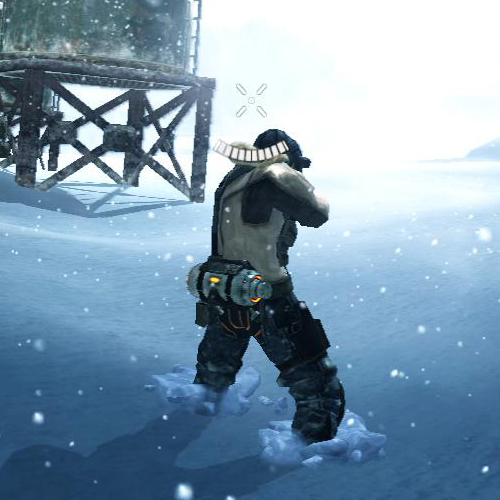
Lost Planet DirectX 9

Lost Planet DirectX 10
In order to make as straightforward a comparison as possible, we used the same settings under DX9 and DX10 (meaning everything on high except for shadow quality).
DirectX 9 Tests

Lost Planet DX9 Performance


Lost Planet 4xAA DX9 Performance
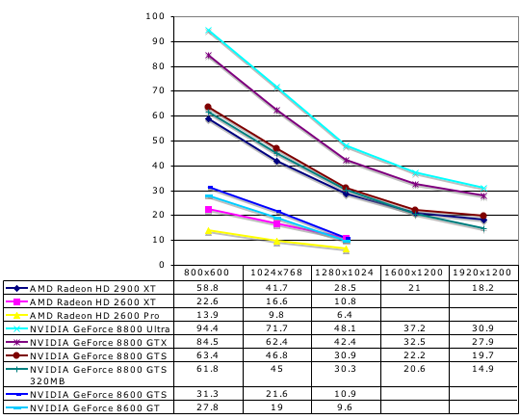
While it's difficult not to feel like a broken record, we need to disable quite a few settings to get our low-end cards playable. In this case, even under DX9 without AA enabled they don't perform well. We are planning on testing the 8500 and 8400 in the near future and we'll be sure and go back to see if we can run DX10 tests at low enough settings to get interesting results for these budget and mainstream parts.
Also, once again, the 2900 XT performs well under DX9, but slips a little behind with 4xAA due to it's lack of MSAA resolve hardware.
DirectX 10 Tests
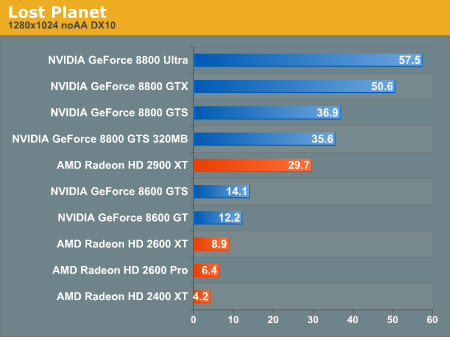
Lost Planet DX10 Performance
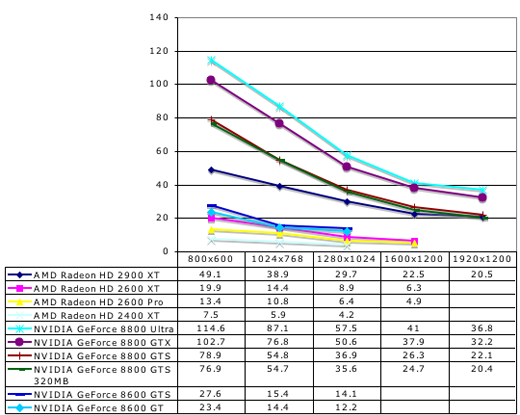
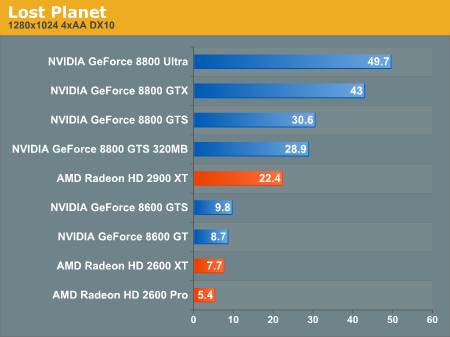
Lost Planet 4xAA DX10 Performance
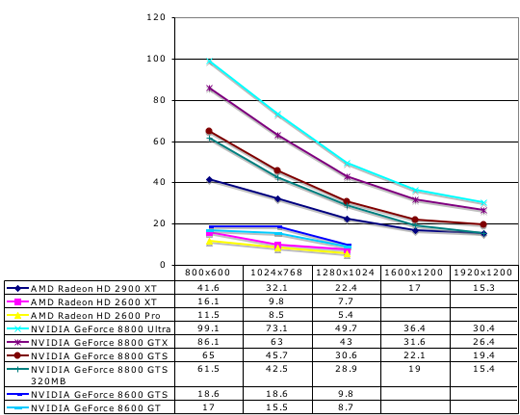
Incredibly, NVIDIA's 162 drivers combined with the retail version of Lost Planet actually deliver roughly equivalent performance on DX9 and DX10. While Capcom's goal is higher performance under DX10, we would still expect that AMD and NVIDIA both have a long way to go in bringing their DX10 drivers up to parity with the quality of their DX9 drivers.
Lost Planet: Extreme Condition is a port of an Xbox 360 game. Well, to be honest, it's almost as if they just tacked on support for a keyboard and mouse and recompiled it for Windows on x86 hardware. While we haven't done a full review of the game, only playing through the intro and first mission, our initial assessment is that this is absolutely the worst console port ever.
Unless you have an Xbox 360 controller for your PC, the game is almost unplayable. The menus are clunky and difficult to navigate. Moving in and out of different sections of the main menu requires combinations of left and right clicking, which is patently absurd. If during gameplay you wish to change resolutions, you must click the mouse no less than a dozen times. This does not include the need to navigate menus through hovering (who does that?) and the click required to grab the scroll bar in the settings menu.
The console shooter has always had to work hard to compete with the PC. Halo and Halo 2 did quite a good job of stepping up to the plate, and Gears of War really hit one out of the park. But simply porting a mediocre console shooter to the PC does not a great game make.
That said, if you can get past the clunky controls and stunted interface, the visuals in this game are quite stunning. It can also actually be fun and satisfying to shoot up a bunch of Akrid. Our first impression is that a good game could be buried underneath all of the problems inherent in the PC port of Lost Planet, but we'll have to take a closer look to draw a final conclusion on this one.
For now, the important information to take away is what we get from the DirectX 10 version of the game. While we haven't found an explicit list of the differences, our understanding is that the features are generally the same. Under DirectX 10, gamers can choose a "high" shadow quality option while DX9 is limited to "medium". Other than this, it seems lighting is slightly different (though not really better) under DX10. From what we've seen reported, Capcom's goal with DX10 on Lost Planet is to increase performance over their DX9 version.

Lost Planet DirectX 9

Lost Planet DirectX 10
In order to make as straightforward a comparison as possible, we used the same settings under DX9 and DX10 (meaning everything on high except for shadow quality).
DirectX 9 Tests




While it's difficult not to feel like a broken record, we need to disable quite a few settings to get our low-end cards playable. In this case, even under DX9 without AA enabled they don't perform well. We are planning on testing the 8500 and 8400 in the near future and we'll be sure and go back to see if we can run DX10 tests at low enough settings to get interesting results for these budget and mainstream parts.
Also, once again, the 2900 XT performs well under DX9, but slips a little behind with 4xAA due to it's lack of MSAA resolve hardware.
DirectX 10 Tests




Incredibly, NVIDIA's 162 drivers combined with the retail version of Lost Planet actually deliver roughly equivalent performance on DX9 and DX10. While Capcom's goal is higher performance under DX10, we would still expect that AMD and NVIDIA both have a long way to go in bringing their DX10 drivers up to parity with the quality of their DX9 drivers.










59 Comments
View All Comments
DerekWilson - Thursday, July 5, 2007 - link
this is true -- our current information shows that AMD does relatively worse than NVIDIA when compared under DX10 than under DX9.rADo2 - Thursday, July 5, 2007 - link
"there are applications where the 2900 xt does outperform its competition" - where? 2900XT has 22FPS, 8800GTX 24FPS nad 8800ULTRA 26FPS. Despite "crippled for NVIDIA" / "paid by ATI" I see still green camp to outperform ATI.And in Lost Planet NVIDIA has 2x (!) better performance.
It is not even worth considering ATI for purchase.
smitty3268 - Thursday, July 5, 2007 - link
Read the comment again: The point is that the 2900XT does not compete against the 8800GTX, it competes against the 8800GTS, which it did outperform in that test.It certainly isn't the fastest card available, but I could also make a statement like "The GeForce7300Go outperforms it's competition" without saying it's the fastest thing available. I'm just saying it beats the cards in a similar price range.
KeithTalent - Thursday, July 5, 2007 - link
Um, what about price? Last time I checked the 8800GTX still costs about $150 more than the 2900XT. I will not even bring up the Ultra which is still way overpriced.So for $150 less you get a card that competes with the GTX some of the time and is more than capable of playing most games maxed out at high resolution. That is why the 2900XT is worth considering for purchase.
KT
rADo2 - Thursday, July 5, 2007 - link
Problem is, 2900XT is many times NOT playable. Its performance is sometimes close to NVIDIA, sometimes 2x lower. And this applies for both DX9 and DX10. With 60+ games I own, I can assume ATI would "suck" on 30 of them.Look at Lost Planet with AA, 22FPS versus 40-50FPS is a huge difference in playability. On 8800GTX/ULTRA you can play even at 1920x1200 (30FPS), with 2900XT even 1280x1024 is giving you problems.
KeithTalent - Thursday, July 5, 2007 - link
Well I have two of them and they work more than fine on every single game I have tried so far, including demos, betas, and a couple of older games (using Catalyst 7.6).Lost Planet is a POS port anyway, but when I ran the test benchmark in DX9 with Crossfired 2900XTs I had frames well above 40 with everything maxed at 1920x1200 so I am somewhat confused by the numbers here. I will have to wait until I am home to see my exact numbers, but they were much higher than what was presented here. Maybe there is something wonky with the beta drivers?
I'll post back tonight once I have verified my numbers.
KT
DerekWilson - Thursday, July 5, 2007 - link
We didn't use the demo benchmark, and the release version (afaik) does not include an updated version of the benchmark either.For the Lost Planet test, we had to use FRAPS running through the snow. This will absolutely give lower performance, as the benchmark runs through a couple in door scenes as well with higher framerates.
I mentioned FRAPS on the test page, but I'll add to the Lost Planet section the method we used for testing.
defter - Thursday, July 5, 2007 - link
Do Intel CPUs outperform currently AMD or not? After all, $200 AMD CPU is about as fast as $200 Intel CPU....It's natural that slower parts have good price/peformance ratio compared to competition since otherwise nobody would buy them. However, this has nothing to do which one fastest...
KeithTalent - Thursday, July 5, 2007 - link
Not sure what you are getting at, I was responding to this ridiculous statement:Which is completely untrue, because price can be a big consideration.
With respect to CPUs, if you spend an extra $50 - $100 for the better Intel processor, you are getting exponentially better performance (I know this from experience), while if you spend $150 more for a GTX, you are getting only marginally better performance.
KT